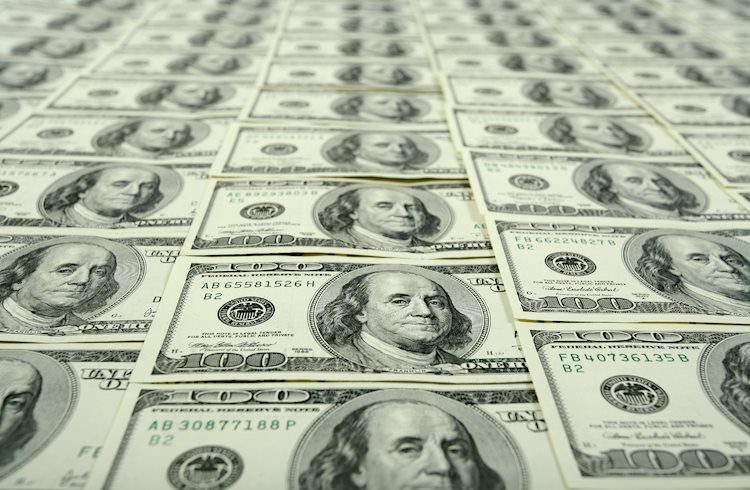
- The DXY Index trades with gains at 102.50 after dipping to 102.10.
- Markets turns risk-averse on Tuesday, seeking refuge in the US Dollar.
- CPI inflation figures from December are the week’s highlight on Thursday.
The US Dollar (USD) Index trades on an upward trajectory on Tuesday, touching the 102.50 mark and largely buoyed by the prevailing negative market sentiment that is bolstering the demand for the Greenback. Furthermore, investors are keeping a keen eye on the Consumer Price Index (CPI) outcome on Thursday as a potential determinant of the pair’s movement for the next sessions.
For now, markets are betting on five rate cuts in 2024, largely dismissing the Federal Reserve (Fed) forecast of only 75 bps of easing. Strong labor market data from the US economy was largely offset by a weak US ISM PMI print, so December’s CPI reading will play a big role in shaping expectations of the central bank’s easing calendar.
Daily digest market movers: US dollar rises on negative market sentiment, eyes on CPI
- The negative market mood fuels an increase in the demand for the USD as investors turn cautious ahead of CPI figures.
- The December Consumer Price Index is projected to come in at 3.2% YoY, above the previous 3.1%. The core annual reading, however, is expected at 3.8%, easing from 4% in November.
- US bond yields exhibit a mixed behavior, with the 2-year yield at 4.38%, the 5-year yield nearly at 4%, and the 10-year yield hovering a little above 4%.
- The CME FedWatch Tool suggests that the January meeting is expected to maintain rates with low chances of a cut. Markets are now pricing in higher odds of future rate cuts come March and May 2024.
Technical Analysis: DXY Index bulls make another stride and consolidate above the 20-day SMA
The Dollar Index’s Relative Strength Index (RSI) is currently on a positive slope in positive territory, hinting at an energized buying momentum. This is further confirmed by the Moving Average Convergence Divergence (MACD) displaying rising green bars, which reinforce the building’s bullish momentum. On the daily chart, the indications are that bulls are gradually reclaiming territory.
However, turning toward the Simple Moving Averages (SMAs), on a broader scope they provide a slightly contradictory outlook. Though the pair sits consolidated above the 20-day SMA, bolstering the short-term bullish viewpoint, it resides below the 100 and 200-day SMAs. This placement reveals that bears are still in command of the overall trend despite short-term bullishness.
Support levels: 102.30, 102.00 (20-day SMA), 101.80.
Resistance levels: 102.70, 102.90, 103.00.
Risk sentiment FAQs
In the world of financial jargon the two widely used terms “risk-on” and “risk off” refer to the level of risk that investors are willing to stomach during the period referenced. In a “risk-on” market, investors are optimistic about the future and more willing to buy risky assets. In a “risk-off” market investors start to ‘play it safe’ because they are worried about the future, and therefore buy less risky assets that are more certain of bringing a return, even if it is relatively modest.
Typically, during periods of “risk-on”, stock markets will rise, most commodities – except Gold – will also gain in value, since they benefit from a positive growth outlook. The currencies of nations that are heavy commodity exporters strengthen because of increased demand, and Cryptocurrencies rise. In a “risk-off” market, Bonds go up – especially major government Bonds – Gold shines, and safe-haven currencies such as the Japanese Yen, Swiss Franc and US Dollar all benefit.
The Australian Dollar (AUD), the Canadian Dollar (CAD), the New Zealand Dollar (NZD) and minor FX like the Ruble (RUB) and the South African Rand (ZAR), all tend to rise in markets that are “risk-on”. This is because the economies of these currencies are heavily reliant on commodity exports for growth, and commodities tend to rise in price during risk-on periods. This is because investors foresee greater demand for raw materials in the future due to heightened economic activity.
The major currencies that tend to rise during periods of “risk-off” are the US Dollar (USD), the Japanese Yen (JPY) and the Swiss Franc (CHF). The US Dollar, because it is the world’s reserve currency, and because in times of crisis investors buy US government debt, which is seen as safe because the largest economy in the world is unlikely to default. The Yen, from increased demand for Japanese government bonds, because a high proportion are held by domestic investors who are unlikely to dump them – even in a crisis. The Swiss Franc, because strict Swiss banking laws offer investors enhanced capital protection.
- SEO Powered Content & PR Distribution. Get Amplified Today.
- PlatoData.Network Vertical Generative Ai. Empower Yourself. Access Here.
- PlatoAiStream. Web3 Intelligence. Knowledge Amplified. Access Here.
- PlatoESG. Carbon, CleanTech, Energy, Environment, Solar, Waste Management. Access Here.
- PlatoHealth. Biotech and Clinical Trials Intelligence. Access Here.
- Source: https://www.fxstreet.com/news/us-dollar-gains-traction-as-negative-market-mood-fuels-recovery-202401091820



